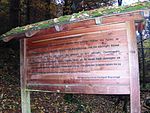Walkenried
Duchy of BrunswickGöttingen (district)Göttingen district geography stubsMunicipalities in Lower SaxonyPages with German IPA ... and 1 more
Villages in the Harz

Walkenried (German pronunciation: [valkənˈʁiːt]) is a municipality in the district of Göttingen, in Lower Saxony, Germany. It is situated in the southern Harz, approx. 15 km south of Braunlage, and 15 km northwest of Nordhausen. Walkenried was the seat of the Samtgemeinde ("collective municipality") Walkenried, which was abolished in November 2016 when Wieda and Zorge were incorporated into the municipality. The village was principally known as the location of Walkenried Abbey, the third Cistercian monastery established on German-speaking territory, founded in 1127 and secularised in 1668.
Excerpt from the Wikipedia article Walkenried (License: CC BY-SA 3.0, Authors, Images).Walkenried
Kupferbergstraße,
Geographical coordinates (GPS) Address Nearby Places Show on map
Geographical coordinates (GPS)
| Latitude | Longitude |
|---|---|
| N 51.586944444444 ° | E 10.618888888889 ° |
Address
Kupferbergstraße
Kupferbergstraße
37445
Lower Saxony, Germany
Open on Google Maps






